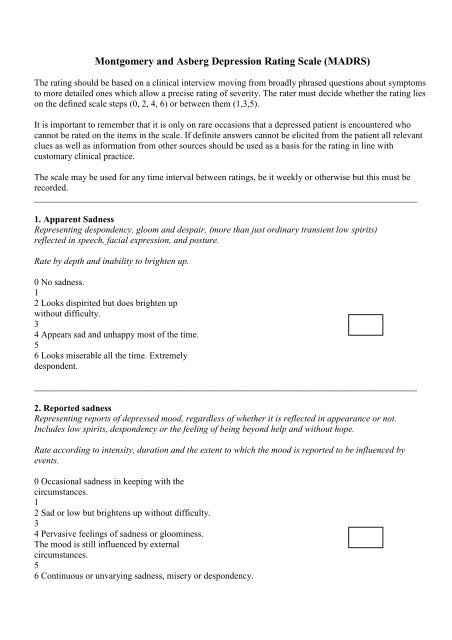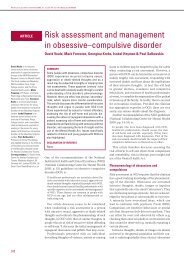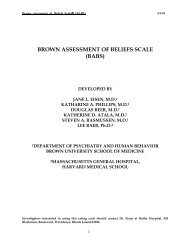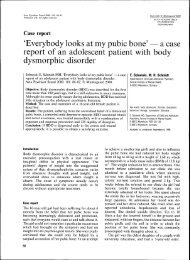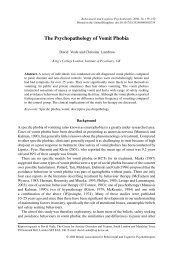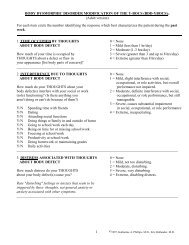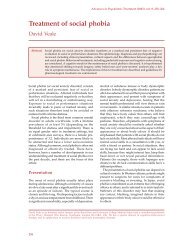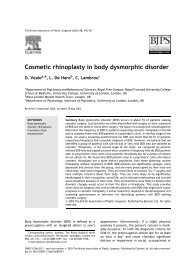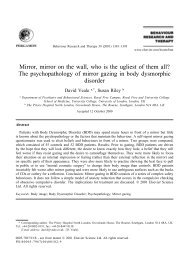Montgomery and Asberg Depression Rating Scale (MADRS)
Montgomery and Asberg Depression Rating Scale (MADRS)
Montgomery and Asberg Depression Rating Scale (MADRS)
Create successful ePaper yourself
Turn your PDF publications into a flip-book with our unique Google optimized e-Paper software.
<strong>Montgomery</strong> <strong>and</strong> <strong>Asberg</strong> <strong>Depression</strong> <strong>Rating</strong> <strong>Scale</strong> (<strong>MADRS</strong>)The rating should be based on a clinical interview moving from broadly phrased questions about symptomsto more detailed ones which allow a precise rating of severity. The rater must decide whether the rating lieson the defined scale steps (0, 2, 4, 6) or between them (1,3,5).It is important to remember that it is only on rare occasions that a depressed patient is encountered whocannot be rated on the items in the scale. If definite answers cannot be elicited from the patient all relevantclues as well as information from other sources should be used as a basis for the rating in line withcustomary clinical practice.The scale may be used for any time interval between ratings, be it weekly or otherwise but this must berecorded.____________________________________________________________________________________1. Apparent SadnessRepresenting despondency, gloom <strong>and</strong> despair, (more than just ordinary transient low spirits)reflected in speech, facial expression, <strong>and</strong> posture.Rate by depth <strong>and</strong> inability to brighten up.0 No sadness.12 Looks dispirited but does brighten upwithout difficulty.34 Appears sad <strong>and</strong> unhappy most of the time.56 Looks miserable all the time. Extremelydespondent.____________________________________________________________________________________2. Reported sadnessRepresenting reports of depressed mood, regardless of whether it is reflected in appearance or not.Includes low spirits, despondency or the feeling of being beyond help <strong>and</strong> without hope.Rate according to intensity, duration <strong>and</strong> the extent to which the mood is reported to be influenced byevents.0 Occasional sadness in keeping with thecircumstances.12 Sad or low but brightens up without difficulty.34 Pervasive feelings of sadness or gloominess.The mood is still influenced by externalcircumstances.56 Continuous or unvarying sadness, misery or despondency.
____________________________________________________________________________________3. Inner tensionRepresenting feelings of ill-defined discomfort, edginess, inner turmoil, mental tension mounting to eitherpanic, dread or anguish.Rate according to intensity, frequency, duration <strong>and</strong> the extent of reassurance called for.0 Placid. Only fleeting inner tension.12 Occasional feelings of edginess <strong>and</strong> illdefined discomfort.34 Continuous feelings of inner tension orintermittent panic which the patient can onlymaster with some difficulty.56 Unrelenting dread or anguish. Overwhelming panic____________________________________________________________________________________4. Reduced sleepRepresenting the experience of reduced duration or depth of sleep compared to the subject's own normalpattern when well.0 Sleeps as usual.12 Slight difficulty dropping off to sleep or slightly reduced, light or fitful sleep.34 Sleep reduced or broken by at least two hours.56 Less than two or three hours sleep____________________________________________________________________________________5. Reduced appetiteRepresenting the feeling of a loss of appetite compared with when well.Rate by loss of desire for food or the need to force oneself to eat.0 Normal or increased appetite.12 Slightly reduced appetite.34 No appetite. Food is tasteless.56 Needs persuasion to eat at all.
________________________________________________________________________________6. Concentration DifficultiesRepresenting difficulties in collecting one's thoughts mounting to incapacitating lack of concentration.Rate according to intensity, frequency, <strong>and</strong> degree of incapacity produced.0 No difficulties in concentrating.12 Occasional difficulties in collecting one's thoughts.34 Difficulties in concentrating <strong>and</strong> sustainingthought which reduces ability to read or holda conversation.56 Unable to read or converse without great difficulty.____________________________________________________________________________________7. LassitudeRepresenting a difficulty getting started or slowness initiating <strong>and</strong> performing everyday activities.0 Hardly any difficulty in getting started. No sluggishness.12 Difficulties in starting activities.34 Difficulties in starting simple routine activitieswhich are carried out with effort.56 Complete lassitude. Unable to do anything without help.____________________________________________________________________________________8. Inability to feelRepresenting the subjective experience of reduced interest in the surroundings, or activities that normallygive pleasure. The ability to react with adequate emotion to circumstances or people is reduced.0 Normal interest in the surroundings <strong>and</strong> inother people.12 Reduced ability to enjoy usual interests.34 Loss of interest in the surroundings. Loss of feelings or friends<strong>and</strong> acquaintances.56 The experience of being emotionally paralysed, inability tofeel anger, grief or pleasure <strong>and</strong> a complete oreven painful failure to feel for close relatives <strong>and</strong> friends.
____________________________________________________________________________________9. Pessimistic thoughtsRepresenting thoughts of guilt, inferiority, self-reproach, sinfulness, remorse <strong>and</strong> ruin.0 No pessimistic thoughts.12 Fluctuating ideas of failure, self-reproach orself depreciation.34 Persistent self-accusations, or definite butstill rational ideas of guilt or sin. Increasinglypessimistic about the future.56 Delusions of ruin, remorse or unredeemable sin.Self-accusations which are absurd <strong>and</strong> unshakable.____________________________________________________________________________________10. Suicidal thoughtsRepresenting the feeling that life is not worth living, that a natural death would be welcome, suicidalthoughts, <strong>and</strong> preparations for suicide.Suicidal attempts should not in themselves influence the rating.0 Enjoys life or takes it as it comes.12 Weary of life. Only fleeting suicidal thoughts.34 Probably better off dead. Suicidal thoughtsare common, <strong>and</strong> suicide is considered as apossible solution, but without specific plansor intention.56 Explicit plans for suicide when there is anopportunity. Active preparation for suicide.____________________________________________________________________________________* Stuart A. <strong>Montgomery</strong>, B.Sc., M.D.. M.R.C.Psych., Senior Lecturer, Academic Department of Psychiatry,Guy's Hospital Medical School, London, S.E. 1,Marie <strong>Asberg</strong>, M.D.,Karolinska Institute, Stockholm, Sweden* Correspondence.(Received 24 April; revised 30 August 1978)


